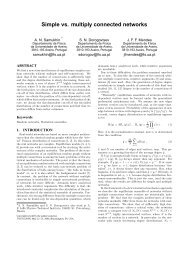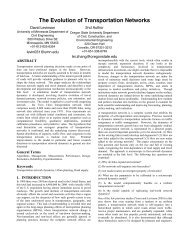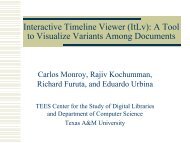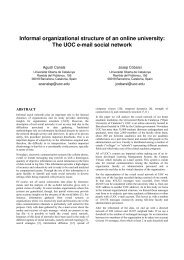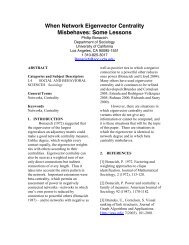Cooperative Robot Teleoperation through Virtual Reality ... - VW
Cooperative Robot Teleoperation through Virtual Reality ... - VW
Cooperative Robot Teleoperation through Virtual Reality ... - VW
You also want an ePaper? Increase the reach of your titles
YUMPU automatically turns print PDFs into web optimized ePapers that Google loves.
Social<br />
Environment<br />
External<br />
Conditions<br />
3. Information to show<br />
Control Center 1 Control Center 2 Supervision Center<br />
Physical Environment<br />
User 1<br />
Fig. 5.- Block elements in the user interaction in a collaborative teleoperation<br />
Technological advancement produces a deluge of<br />
information the user risk drowning. The Internet, an<br />
infinite highway of data, for example, can easily<br />
become an infinite maze. When it comes to robots,<br />
the situation is still more complex. Now it is possible<br />
HMI<br />
Computer:<br />
- Storage<br />
- Processing<br />
<strong>Robot</strong>:<br />
- Sensors<br />
- Operation<br />
Network Link<br />
Physical Environment<br />
User 2<br />
to fill any mechanical shell with literally thousands of<br />
electronic devices and make it function as a robot.<br />
Every one of the robot’s individual sensors provides a<br />
minimum of data that must be processed and that<br />
should, at least in some cases, be shown. In fact, the<br />
sheer quantity of data available for any given situation<br />
amount to information overload (See Table 1).<br />
Visualization: Control:<br />
Working area. The users must be able to see what they are doing in<br />
the teleoperated robot.<br />
Position information and spatial orientation information. This<br />
provides information about where the robot is heading in relation to<br />
the north, the mother ship and to show to the user where they are.<br />
This information might come from Acoustic Transponder Networks,<br />
Doppler, Sonar, Inertial Navigation Systems, GPS, etc.<br />
Navigation information. Some parameters are needed while the<br />
user is driving the robot:<br />
Where the north is.<br />
Speed and depth.<br />
Location of the robot in relation to the sea surface and the<br />
bottom.<br />
Internal system information. Information about the system status<br />
and other technical stuff. These include the visualization of<br />
equipment sensibility, threshold, communication parameters, data<br />
protocol etc.<br />
Numerical information. Show all the numerical data about the<br />
robot. By this function, the user would be able to show or hide –at<br />
convenience-, the task relevant information.<br />
Enhanced displays: <strong>Virtual</strong> image, compass and keymap. These<br />
functions enhance the robot controllability. A compass is a<br />
traditional orientation device to signal the north. A keymap is an<br />
intelligent map showing references about the user location, targets,<br />
origin and location of other virtual marks.<br />
Help information. On-line help is provided in three levels: active<br />
tags, medium information windows and advanced help.<br />
Individual parameters. Additional information helps the user to<br />
understand better the robot operation:<br />
Underwater currents affecting the robot.<br />
Power. The robot internal battery status.<br />
Partners Visualization. Location and movement direction of the<br />
other member of the team in the virtual environment should be<br />
clearly displayed.<br />
Messages in Transit flag. This indicator would warn users about<br />
delayed messages.<br />
HMI<br />
Computer:<br />
- Storage<br />
- Processing<br />
<strong>Robot</strong>:<br />
- Sensors<br />
- Operation<br />
Social<br />
Environment<br />
Physical Environment<br />
User n<br />
Working<br />
Activities<br />
Vehicle control. There are several motors to move the robot in<br />
the six axes of movement and rotational displacement (left and<br />
right).<br />
<strong>Virtual</strong> reality control. Due the virtual reality tool used, now<br />
the user has to deal with the power to change the point of<br />
view.<br />
Interface control. It includes the ability to perform file<br />
operations and other task related to the program and computer.<br />
Arms control. The robot is equipped with external arms to<br />
perform different task. This function activates the robot arms.<br />
Speed control. This function allows the user to increase the<br />
robot speed.<br />
External system control. External lights and specific sensors<br />
are activated by this set of controls. Stabilization (keep the<br />
robot statically in that place) icon is another example of<br />
external system service.<br />
Route definition. Specific routes in the workplace can be<br />
defined using this function.<br />
Internal system configuration. Using this function, which will<br />
open a window with all the configurable options, can set up<br />
the robot internal system. These include the sensors available<br />
to measure the motors performance and calibration of sonar<br />
system, range finder, communication parameters, data<br />
protocol, etc.<br />
Bottom sea configuration. The virtual bottom sea should be<br />
configured <strong>through</strong> this function, to allow the users to updated<br />
the working area map (according to new information).<br />
Tracking Control. This function would allow the user to track<br />
specific objects (pipeline, etc) or other robots in the working<br />
environment.<br />
Message control. Transmitting information to the other peers<br />
and to the master is fundamental in a collaborative scheme.<br />
Flag mark control. The user may decide to place a signal in<br />
the virtual environment visible for other teams working with<br />
other robots (tagging an area) or to signal places for direction<br />
purposes.<br />
Table 1.- Requirements in teleoperation for visualization and control for underwater robots<br />
HMI<br />
Computer:<br />
- Storage<br />
- Processing<br />
Network Link<br />
Social<br />
Environment



